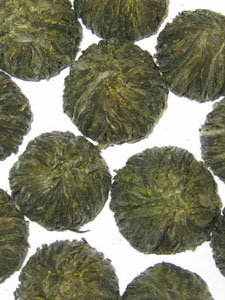Specialty Teas: Bird Nests and Dragon Balls



You have surely seen tea leaves run the gamut of very large (Formosa oolongs) to very small (Chinese blacks). And know that they may be full leaf or broken, ground to a powder or mixed with the essences of fruit, flowers or herbs. But have you tried tea leaves molded or tied into elegant and whimsical shapes?
Balls Ever since the "discovery" of tea in 2700 B.C., tea manufacturers have experimented with withering and drying techniques both to enhance flavor and prolong the life of this precious leaf. One of the earliest innovations was the ball (chu), sometimes referred to as a pearl because it resembles the traditional 6 mm cultured pearl. Though these may be made from many types of teas, green and white varieties remain the most popular. Balls (or pearls) are leaves that are rolled together until the desired size and shape are achieved.
One famous black ball tea is He Lung Chu (black dragon ball.) These large balls of tea are about the size of an agate marble, and infuse a rich bright yellow brew. A white dragon ball, Pai Loong Chu, is slightly smaller and produces a lovely pale sage color in the bowl.
In the late 1700s green tea leaves were rolled into what has become the most famous shaped tea: tiny balls by the Chinese called Lo Chu Ch'a. The British called them gunpowder because they so resembled the ammunition pellets they used. The rolling technique was not just for charm, but a clever way of making the green leaves less vulnerable to the elements and age.
Another version of the ball is actually a ring, much like a roll of ribbon. These are typically called jade rings, made of green tea leaves, and sometimes go by the Chinese name, Yuet Wah Ch'a. They unfurl as they infuse and offer a delicate yet distinctly green taste in the cup.
To brew balls of tea, fill a small scoop or teaspoon with them, and steep as you would, depending upon their type (white, green, oolong or black.)
Needles The Japanese roll green tea into very long spikes they call "spider legs" and the Chinese roll white teas into long "silver needles". These were first created during the Tang Dynasty (A.D. 618-907) after a legend of the White Crane Lake of Chun Shan where the water to brew this famous tea first came from, served as a gift to the king. Yin Chin means silver needle, and the Chinese consider Chun Shan Yin Chin a yellow tea although many vendors consider it a white tea.
Both spider legs and silver needles benefit from being brewed in tall clear glass tumblers. As the leaves infuse they "tumble down" the center of the glass in a form of tea dance that will enchant you and your guests. (Once referred to as the "agony of the leaves," it is a more comforting description to call this the "dance of the tea leaves.")
Bricks Rectangular bricks of tea were the result of an elaborate process, developed during the Sung Dynasty (A.D. 960-1279.) Tea was steamed, squeezed of its moisture, hand pressed and rolled, and then ground. This tea powder was first used to spice soups and made an "instant tea," but soon the Chinese tea manufacturers were pressing the wet tea powder into tea cakes. These circular or disc shaped tea balls and bricks were baked at a high temperature, often up to three times. The tea bricks (much like tea itself) became so valuable with traders it was used as a form of currency. Today, tea bricks are more frequently used as decorative plaques for the wall, but they can be used for drinking just as they were centuries ago. Just break off a small chunk, place it in the pot and pour on very hot to just-about boiling water. Steep to taste as you would any black tea.
Mudans The Chinese have been very creative in developing shapes and forms for what are now known as "showplace" teas. Most of these are named for the shapes that they are: anemones, strawberries, hummingbird's nests, peonies, or referred to by their Chinese name, mudan. The tea leaves, usually green, are tied together with very fine silk or other tea leaves and left to dry to their eponymous shape. In nests and other forms, they are woven or pressed into shape with a small indentation on top.
To best enjoy your mudan, place it in a champagne or white wine glass and pour in hot water (170-185 degrees F.) and the tea will infuse slowly, some twenty to thirty minutes. Because of their complexity of form and the lower water temperature used for brewing, the mudan can infuse while you dine, and you can drink it at the end of the meal. In the meantime, you'll have a "show" to watch as the mudan fluffs into its signature shape. Children and tea neophytes are particularly fascinated by this method of tea brewing and it's a great way to introduce better grades of teas to friends and family.
Next time you're looking for something entertaining to do with tea, consider the many shapes of teas: balls and pearls, nests, mudans and rolled spikes of leaves. It will add fun and flavor to the tea drinking experience.
